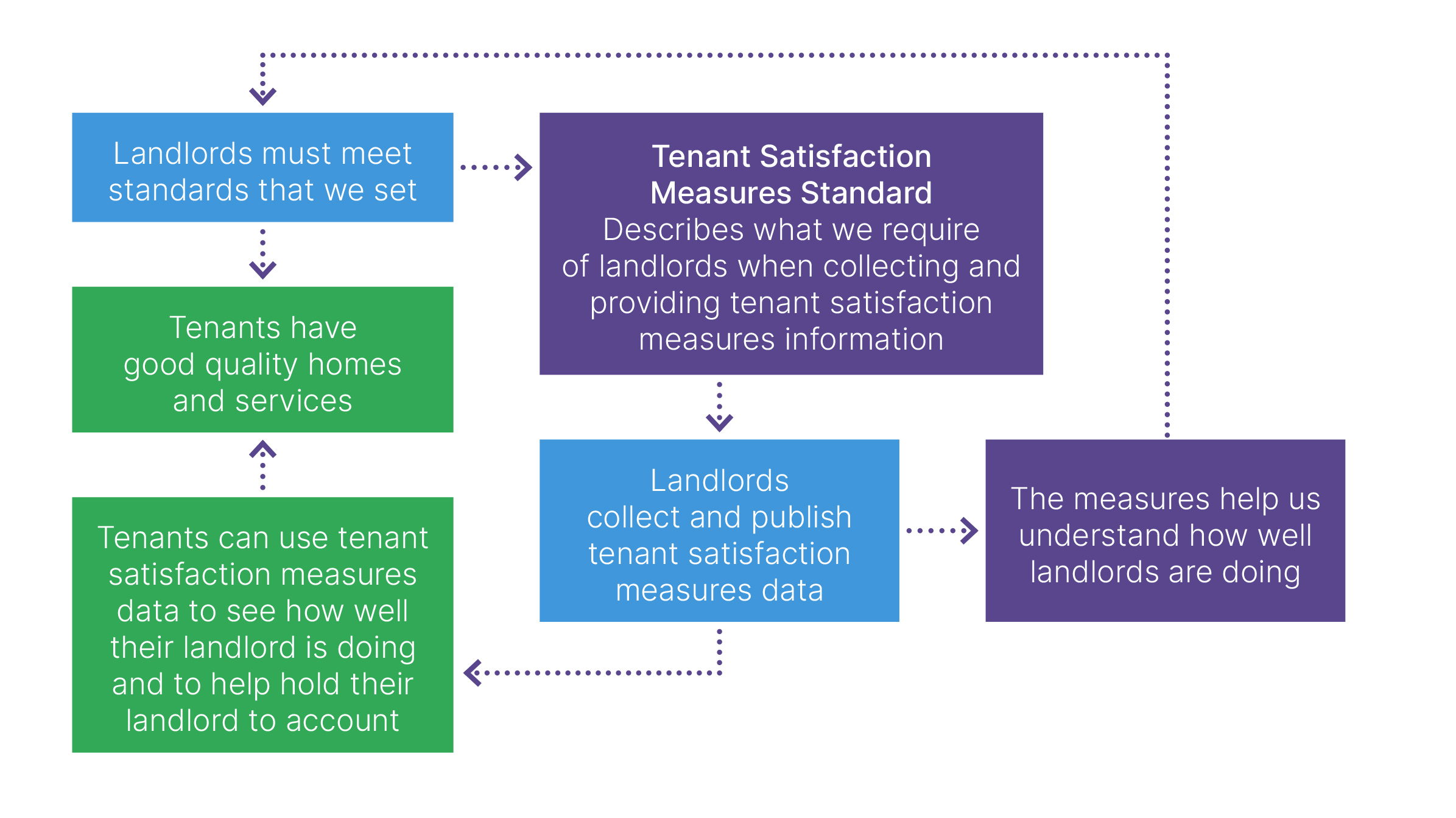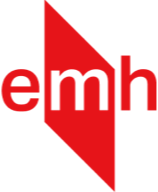Property management and building compliance
On this page we explain what Tenant Satisfaction Measures are and what you can expect from us as your landlord. We also explain the Decent Homes Standard and how we keep our buildings and your home safe.

Tenant Satisfaction Measures (TSMs)
What are they?
They are a new system of measures, introduced by the Regulator of Social Housing, for assessing how well social housing landlords in England are doing at providing good quality homes and services.
emh as a social landlord must report on these tenant satisfaction measures (TSMs) and people will be able to use these measures to understand how well we and other landlords are doing. Below shows a breakdown of all 22 TSMs:
This first set are measured by a tenant perception survey:
 Overall satisfaction
Overall satisfaction- Satisfaction with repairs
- Satisfaction with time taken to complete most recent repair
- Satisfaction that the home is well maintained
- Satisfaction that the home is safe
- Satisfaction that the landlord listens to tenant views and acts upon them
- Satisfaction that the landlord keeps tenants informed about the things that matter
- Agreement that the landlord treats tenants fairly and with respect
- Satisfaction with the landlord's approach to handling complaints
- Satisfaction that the landlord keeps communal areas clean and well maintained
- Satisfaction that the landlord makes a positive contribution to neighbourhoods
- Satisfaction with the landlord's approach to handling anti-social behaviour
These are measured by our own management information and systems:
- Complaints relative to the size of the landlord
- Complaints responded to within Complaint Handling Code timescales
- Anti-social behaviour cases relative to the size of the landlord
- Homes that do not meet the Decent Homes Standard
- Repairs completed within target timescales
- Gas safety checks
- Fire safety checks
- Asbestos safety checks
- Water safety checks
- Lift safety checks
How will they work?

What are emh doing?
Keeping properties in good repair
Decent Homes Standard
This measure is based on the percentage of a landlord’s homes that do not meet the Decent Homes Standard.
The standard was introduced by the government and applies to the social housing rented sector and covers landlords like emh. The standard gives detailed definitions of each of the four criteria that make up the Decent Homes standard to ensure at least a minimum standard is set and monitored against the national target by all social landlords.
The four criteria are detailed below:
A: It meets the current statutory minimum standard for housing.
B: It is in a reasonable state of repair.
C: It has reasonably modern facilities and services.
D: It provides a reasonable degree of thermal comfort.
Repairs completed within target timescale
This measure is based on the percentage of repairs the landlord has done within the target time they have set for themselves. As part of this measure, landlords have to make these target times public. Both emergency and non-emergency repairs requested by tenants are measured. Repairs planned by the landlord are not included.
Planned component replacement
We carry out stock condition surveys every five years to review the condition and age of building components in our properties.
- Roof finish – replaced on condition and age post 50 years
- Windows – replaced on condition and age circa 30 years
- Kitchens – replaced on condition and age circa 20 years
- Bathrooms - replaced on condition and age circa 30 years
- Main entrance front and rear doors – replaced on condition and age circa 30 years.
Maintaining building safety
emh has a 'core asset management' system that holds data on gas safety checks, fire risk assessments (fire safety checks), asbestos management and re-inspection surveys (asbestos safety checks), Legionella risk assessments (water safety checks), and lift safety checks. This links into a live dashboard to show the percentage of compliance against each area, as well as any non-compliance and allows the data to be broken down to property level. The core system is updated each time a check is completed to ensure that it captures the most up to date information.
Gas safety checks
emh aims to provide its residents with homes that are safe, comfortable and well maintained. The Gas Safety (Installation and Use) Regulations 1998 require us to carry out a gas safety check of all domestic gas appliances on an annual basis. In addition, we carry out a gas appliances service in conjunction with the gas safety check and complete all necessary repairs and replacements promptly. The engineer will also test your smoke detection devices and ensure you have a working carbon monoxide alarm in place. The Gas Safety Certificate that is completed for your annual service, is then updated to our core asset management system.
Fire safety checks
For all our properties that are in a block of flats (aka a multi-occupied residential building) the shared common areas have a fire risk assessment undertaken either on an annual or two-yearly basis. This is in line with the requirements set out in the Fire Safety Act 2021 and The Regulatory Reform (Fire Safety) Order 2005. The frequency is determined by emh's fire safety policy, which looks at height, use and external fire safety advice. The completed fire risk assessment review is then updated in our core asset management system.
emh is in a 'primary authority partnership' with Derbyshire Fire and Rescue Service, this allows us to consult with them on all fire safety matters across our properties and attain assured advice from them to better manage fire safety in all buildings and promote a positive fire safety culture.
To see a copy of the most recent fire risk assessment (FRA) for the building you live in or if you have any queries or concerns, please get in touch.
You will receive an annual fire safety booklet that contains important information on how to help keep you and your family safe. Please ensure you read it. If you need a reminder here is a link to the booklet.
Asbestos safety checks
For properties that were built before the year 2000 (when the use of asbestos was banned), emh has a programme of asbestos re-inspection surveys that we carry out annually across all non-domestic premises and common parts (communal areas) of residential properties. We then use this information to update our core asset management system. This ensures emh meets its legal obligations under the Control of Asbestos Regulations 2012 – duty to manage. Regulation 4 of CAR 2012, details the legal duty for providers to manage asbestos in non-domestic premises including common parts of residential properties (e.g., communal areas of housing blocks and schemes).
It is important to note that emh’s domestic properties (tenanted homes) with no communal areas do not fall into the TSM reporting requirement. However, emh does have a risk-based approach to monitoring any asbestos containing materials located within these properties.
For information on any asbestos relating to your property, please contact us. If you are aware of any asbestos containing material and believe that its condition has deteriorated, please report this immediately and emh can send a competent surveyor out to assess the risk.
Water safety checks
We recognise the potential health and safety risks associated with stored water installations and systems that are under our control. To help reduce the risk of Legionnaires disease we carry out a new Legionella risk assessment every six years to our non-domestic properties, which is reviewed internally every two years or if significant changes occur. This includes our schemes that have shared stored water systems. Once a risk assessment or review is completed, it is then updated within our core asset management system. This complies with both the Approved Code of Practice L8 and HSG274, and help emh to comply with its legal duties in relation to legionella.
Additionally, when a property is empty the empty homes (voids) team carry out a risk assessment to determine any risk based on the hot and cold water system in place. Once an initial risk assessment has taken place and any remedial works carried out and outlets flushed, the property can be relet. If you have any concerns about your home's water system, please get in touch.
If you're using your taps regularly and water is running through the system, you are at very low risk of Legionaires disease. To further reduce risk remember to flush your unused outlets weekly and keep your outlets and shower heads clean.
Lift safety checks
emh is an employer that provides lifting equipment for use at work, and has control of the use of lifting equipment. This means we must make sure the lifting equipment is safe. The main requirements for a duty holder are in the Provision and Use of Work Equipment Regulations 1998 (PUWER) and the Lifting Operations and Lifting Equipment Regulations 1998 (LOLER).
LOLER applies directly to passenger lifts. emh as a landlord is required to ensure that all lifts, when in use, are thoroughly examined every six months where the lift is used to carry people. Through our insurance we procure a competent company to carry out the six-monthly LOLER safety checks on the passenger lifts within our properties. Once an inspection is completed and a report issued, the information is updated within the core asset management system.
If you have any concerns about a passenger lift within your building please contact emh immediately.
